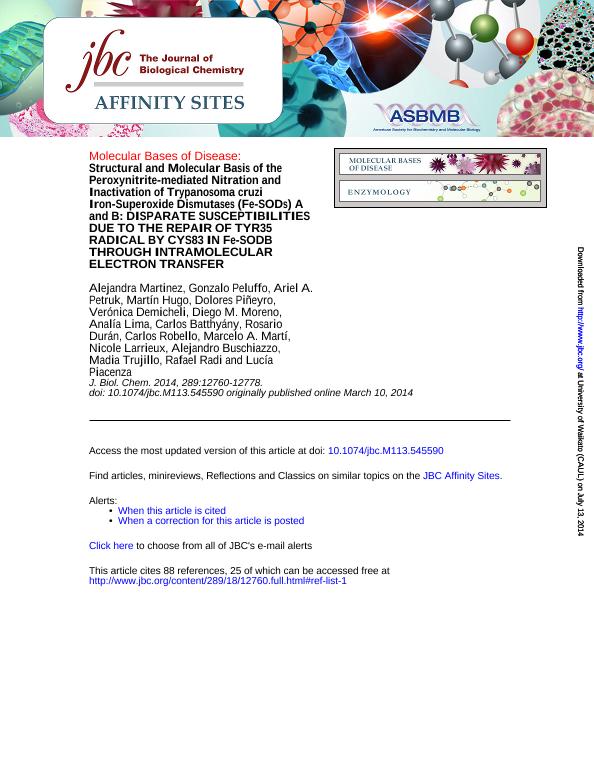Artículo
Structural and molecular basis of the peroxynitrite-mediated nitration and inactivation of Trypanosoma Cruzi iron-superoxide dismutases (fe-sods) A and B. Disparate susceptibilities due to the repair of tyr35 radical by cys83 in fe-sodb through intramolecular electron transfer
Martinez, Alejandra ; Peluffo, Gonzalo; Petruk, Ariel Alcides
; Peluffo, Gonzalo; Petruk, Ariel Alcides ; Hugo, Martín; Piñeyro, Dolores; Demicheli, Veronica; Moreno, Diego Martin
; Hugo, Martín; Piñeyro, Dolores; Demicheli, Veronica; Moreno, Diego Martin ; Lima, Analia Ethel
; Lima, Analia Ethel ; Batthyány, Carlos; Duran, Rosario; Robledo, Carlos Walter; Marti, Marcelo Adrian
; Batthyány, Carlos; Duran, Rosario; Robledo, Carlos Walter; Marti, Marcelo Adrian ; Larrieux, Nicole; Buschiazzo, Alejandro; Trujillo, Madia; Radi, Rafael; Piacenza, Lucia
; Larrieux, Nicole; Buschiazzo, Alejandro; Trujillo, Madia; Radi, Rafael; Piacenza, Lucia
 ; Peluffo, Gonzalo; Petruk, Ariel Alcides
; Peluffo, Gonzalo; Petruk, Ariel Alcides ; Hugo, Martín; Piñeyro, Dolores; Demicheli, Veronica; Moreno, Diego Martin
; Hugo, Martín; Piñeyro, Dolores; Demicheli, Veronica; Moreno, Diego Martin ; Lima, Analia Ethel
; Lima, Analia Ethel ; Batthyány, Carlos; Duran, Rosario; Robledo, Carlos Walter; Marti, Marcelo Adrian
; Batthyány, Carlos; Duran, Rosario; Robledo, Carlos Walter; Marti, Marcelo Adrian ; Larrieux, Nicole; Buschiazzo, Alejandro; Trujillo, Madia; Radi, Rafael; Piacenza, Lucia
; Larrieux, Nicole; Buschiazzo, Alejandro; Trujillo, Madia; Radi, Rafael; Piacenza, Lucia
Fecha de publicación:
05/2014
Editorial:
American Society for Biochemistry and Molecular Biology
Revista:
Journal of Biological Chemistry (online)
ISSN:
0021-9258
Idioma:
Inglés
Tipo de recurso:
Artículo publicado
Clasificación temática:
Resumen
Trypanosoma cruzi, the causative agent of Chagas disease, contains exclusively iron-dependent superoxide dismutases (Fe-SODs) located in different subcellular compartments. Peroxynitrite, a key cytotoxic and oxidizing effector biomolecule, reacted with T. cruzi mitochondrial (Fe-SODA) and cytosolic (Fe-SODB) SODs with second order rate constants of 4.6 ± 0.2 × 104 M−1 s−1 and 4.3 ± 0.4 × 104 M−1 s−1 at pH 7.4 and 37 °C, respectively. Both isoforms are dose-dependently nitrated and inactivated by peroxynitrite. Susceptibility of T. cruzi Fe-SODA toward peroxynitrite was similar to that reported previously for Escherichia coli Mn- and Fe-SODs and mammalian Mn-SOD, whereas Fe-SODB was exceptionally resistant to oxidant-mediated inactivation. We report mass spectrometry analysis indicating that peroxynitrite-mediated inactivation of T. cruzi Fe-SODs is due to the site-specific nitration of the critical and universally conserved Tyr35. Searching for structural differences, the crystal structure of Fe-SODA was solved at 2.2 Å resolution. Structural analysis comparing both Fe-SOD isoforms reveals differences in key cysteines and tryptophan residues. Thiol alkylation of Fe-SODB cysteines made the enzyme more susceptible to peroxynitrite. In particular, Cys83 mutation (C83S, absent in Fe-SODA) increased the Fe-SODB sensitivity toward peroxynitrite. Molecular dynamics, electron paramagnetic resonance, and immunospin trapping analysis revealed that Cys83 present in Fe-SODB acts as an electron donor that repairs Tyr35 radical via intramolecular electron transfer, preventing peroxynitrite-dependent nitration and consequent inactivation of Fe-SODB. Parasites exposed to exogenous or endogenous sources of peroxynitrite resulted in nitration and inactivation of Fe-SODA but not Fe-SODB, suggesting that these enzymes play distinctive biological roles during parasite infection of mammalian cells.
Archivos asociados
Licencia
Identificadores
Colecciones
Articulos(INQUIMAE)
Articulos de INST.D/QUIM FIS D/L MATERIALES MEDIOAMB Y ENERGIA
Articulos de INST.D/QUIM FIS D/L MATERIALES MEDIOAMB Y ENERGIA
Articulos(IQUIR)
Articulos de INST.DE QUIMICA ROSARIO
Articulos de INST.DE QUIMICA ROSARIO
Citación
Martinez, Alejandra; Peluffo, Gonzalo; Petruk, Ariel Alcides; Hugo, Martín; Piñeyro, Dolores; et al.; Structural and molecular basis of the peroxynitrite-mediated nitration and inactivation of Trypanosoma Cruzi iron-superoxide dismutases (fe-sods) A and B. Disparate susceptibilities due to the repair of tyr35 radical by cys83 in fe-sodb through intramolecular electron transfer; American Society for Biochemistry and Molecular Biology; Journal of Biological Chemistry (online); 289; 5-2014; 12760-12778
Compartir
Altmétricas



